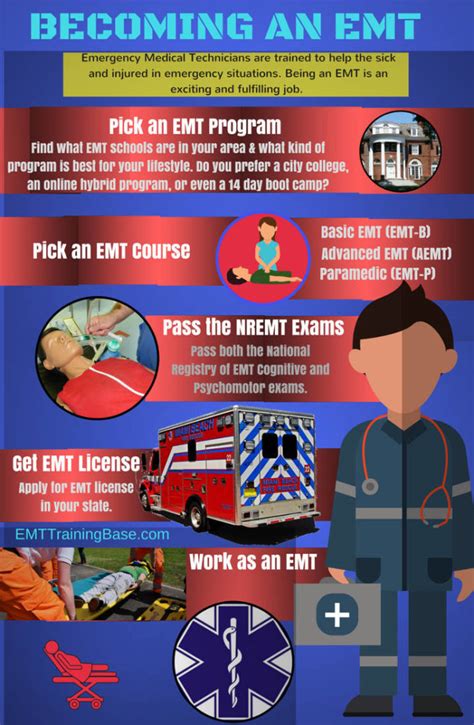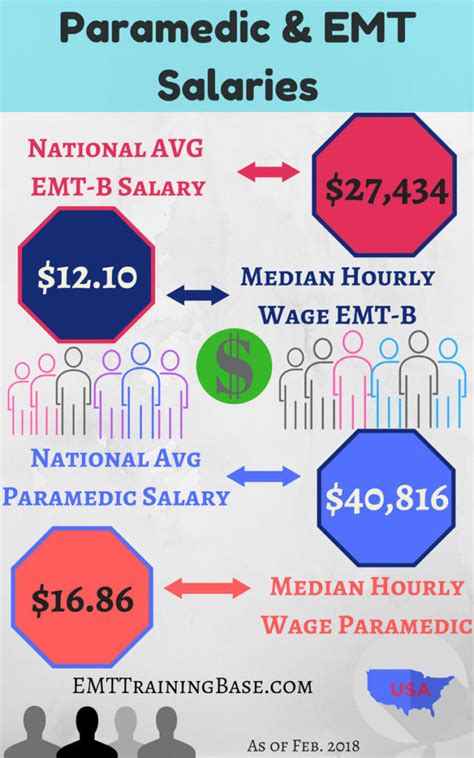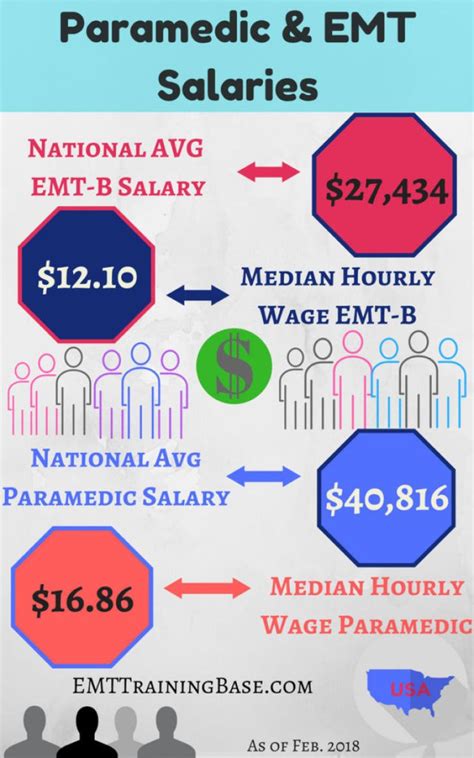Choosing a career as an Emergency Medical Technician (EMT) is a commitment to serving your community during its most vulnerable moments. It's a path defined by purpose, quick thinking, and compassion. But for those considering this vital profession, a practical question is just as important: What is the earning potential?
While the true rewards of this job are often intangible, understanding the financial landscape is crucial for career planning. The average EMT salary per hour can vary significantly, but with the right training, experience, and location, it can provide a stable and rewarding livelihood. Nationally, the median hourly wage for EMTs and paramedics hovers around $23.60, but many factors can push that figure higher.
This article will provide a data-driven breakdown of EMT salaries, explore the key factors that influence your pay, and examine the future job outlook for this essential healthcare role.
What Does an EMT Do?

Before diving into the numbers, it's important to understand the role. EMTs are the frontline of emergency medical services. They are typically the first healthcare professionals to arrive at the scene of an accident or medical crisis.
Their core responsibilities include:
- Responding to 911 calls for emergency medical assistance.
- Quickly assessing a patient's condition and determining a course of treatment.
- Providing immediate life-saving care, such as CPR, administering oxygen, or treating wounds.
- Safely transporting patients to hospitals or other medical facilities.
- Reporting their observations and treatment to emergency room staff.
EMTs work in high-stress, fast-paced environments where every second counts. It's a physically and emotionally demanding job that requires resilience, calm under pressure, and a deep sense of empathy.
Average EMT Salary Per Hour

When analyzing compensation, it's best to start with the national benchmarks and then explore the variables.
According to the most recent data from the U.S. Bureau of Labor Statistics (BLS) Occupational Outlook Handbook (May 2023), the median hourly wage for EMTs and Paramedics is $23.60 per hour. This translates to a median annual salary of $49,080.
A "median" wage is the midpoint—half of all workers in the profession earned more than that amount, and half earned less. The salary range provides a more complete picture:
- Lowest 10%: Earned less than $17.82 per hour ($37,070 annually). These are typically entry-level positions in lower-paying regions.
- Highest 10%: Earned more than $37.52 per hour ($78,040 annually). These top earners are often experienced paramedics, those in specialized roles, or individuals working in high-paying metropolitan areas.
Reputable salary aggregators provide similar figures. For example, Salary.com reports that the typical EMT salary range in the United States falls between $18.50 and $25.00 per hour, confirming the BLS data while highlighting the common pay band for the majority of professionals.
Key Factors That Influence Salary

Your hourly wage as an EMT is not a fixed number. It is influenced by a combination of your qualifications, career choices, and where you work. Understanding these factors is key to maximizing your earning potential.
###
Level of Education and Certification
This is arguably the most significant factor in determining your pay. The "EMT" title covers several levels of certification, each with a distinct scope of practice and earning potential.
- EMT-Basic (EMT-B): This is the entry-level certification, requiring around 120-150 hours of training. EMTs at this level provide essential life support, such as CPR and bleeding control. They form the backbone of the EMS system but are on the lower end of the pay scale.
- Advanced EMT (AEMT): AEMTs complete additional training that allows them to administer certain medications and perform more advanced procedures, such as starting IV lines. This advanced skill set typically commands a higher hourly wage than an EMT-B.
- Paramedic: This is the highest level of pre-hospital care provider. Paramedic programs involve 1,200 to 1,800 hours of intensive training (often leading to an Associate's degree). Their advanced skills in pharmacology, cardiology, and patient assessment lead to significantly higher salaries. Data from Payscale.com shows that Paramedics can earn 20-30% more per hour than EMT-Basics.
###
Years of Experience
As with most professions, experience pays. Seasoned EMTs and paramedics are valued for their field-tested judgment and ability to handle complex situations.
- Entry-Level (0-2 years): New EMTs typically start at the lower end of the salary range as they build their skills and confidence.
- Mid-Career (3-9 years): With several years of experience, EMTs can expect a steady increase in their hourly wage. They may also take on responsibilities like field training for new hires.
- Senior/Experienced (10+ years): Veteran professionals are the highest earners. Their extensive experience makes them eligible for senior roles, supervisory positions, or specialized teams, all of which come with higher pay.
###
Geographic Location
Where you work has a massive impact on your paycheck, largely due to differences in cost of living, state regulations, and demand.
According to BLS data, the top-paying states for EMTs and paramedics are:
1. Hawaii: $38.90 per hour (median)
2. Washington: $37.49 per hour (median)
3. California: $32.06 per hour (median)
4. Maryland: $31.10 per hour (median)
5. Alaska: $30.82 per hour (median)
Conversely, wages are typically lower in rural areas and in states with a lower cost of living. Furthermore, working in a major metropolitan area often yields a higher hourly rate than working in a smaller town within the same state.
###
Company Type (Work Environment)
The type of organization you work for is another critical factor. The BLS identifies the primary employers and their median wages:
- Local Government (e.g., Fire Departments): Often the highest-paying employers ($26.96/hour median). These positions are highly competitive but offer excellent pay, benefits, and retirement plans.
- Hospitals (State, Local, and Private): A strong employer with competitive wages ($24.32/hour median). EMTs in hospitals may work in the emergency department or on hospital-based transport teams.
- Ambulance Services: This is the largest employer in the field ($22.18/hour median). This category includes private companies that provide 911 response, inter-facility transfers, or non-emergency transport.
- Outpatient Care Centers: This smaller sector offers wages around the national median.
###
Area of Specialization
Advancing your career often involves specializing. These roles require additional training and certification but come with a significant pay bump.
- Firefighter/EMT: Many firefighters are cross-trained as EMTs or paramedics. This dual certification makes them highly valuable and often leads to higher overall compensation packages.
- Flight Paramedic/Critical Care Transport: These elite professionals work on helicopters or fixed-wing aircraft to transport critically ill patients. The advanced training and high-stakes environment command some of the highest salaries in the profession.
- Tactical EMT (TEMS): These EMTs are embedded with law enforcement teams like SWAT to provide immediate medical care in high-risk tactical situations.
Job Outlook

The future for EMTs and paramedics appears stable. According to the BLS, employment in this field is projected to grow by 1% from 2022 to 2032.
While this growth rate is slower than the national average, it doesn't paint the full picture. The BLS projects approximately 19,300 job openings for EMTs and paramedics each year over the decade. These openings arise from the need to replace workers who retire or transition to other occupations, as well as from growing healthcare demands from an aging population. Emergencies, car accidents, and natural disasters create a constant, ongoing need for skilled first responders.
Conclusion: A Career of Impact and Opportunity

An EMT's hourly wage is a complex figure influenced by your level of certification, years on the job, location, and employer. While starting pay may be modest, this career offers clear pathways for financial and professional growth.
For those considering this field, here are the key takeaways:
- The national median wage is a solid benchmark, but your actual earnings can vary widely.
- The single most effective way to increase your salary is to advance your certification from an EMT-Basic to a Paramedic.
- Gaining experience and seeking employment with higher-paying organizations, like local government or hospitals, can significantly boost your income.
- Specializing in areas like flight medicine or firefighting opens doors to the highest earning potential in the field.
Ultimately, a career as an EMT is about more than a paycheck. It is a profoundly rewarding profession that places you at the heart of your community. For those with the courage and dedication to answer the call, it offers a future of stability, growth, and the unparalleled satisfaction of saving lives.
